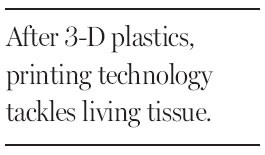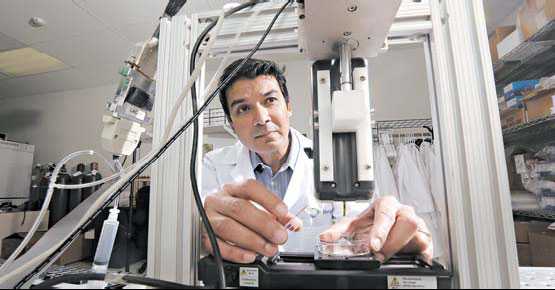For cartilage, skin and other tissue, hit 'print'
Updated: 2013-09-01 08:11
By Henry Fountain(The New York Times)
|
|||||||
|
Darryl D'Lima, an orthopedic specialist, working with a bioprinter in his research on cartilage at the Scripps Clinic in San Diego, California. Sandy Huffaker for The New York Times |
SAN DIEGO, California - Someday printers may churn out hearts, livers and other organs. For now, Darryl D'Lima would settle for a bit of knee cartilage.
Dr. D'Lima, who heads an orthopedic research lab at the Scripps Clinic here, has already made bioartificial cartilage in cow tissue, modifying an old inkjet printer to put down layer after layer of a gel containing living cells. He has also printed cartilage in tissue removed from patients who have undergone knee replacement surgery.
Much work remains to be done, but his goal is to have a printer in the operating room that could custom-print new cartilage directly in the body.
Instead of the plastics or powders used in conventional 3-D printers to build an object layer by layer, so-called bioprinters print cells, usually in a liquid or gel.
At labs around the world, researchers have been experimenting with bioprinting, first just to see whether it was possible to push cells through a printhead without killing them (in most cases it is), and then trying to make cartilage, bone, skin, blood vessels, small bits of liver and other tissues.
But though bioprinting has made strides, many obstacles remain, and printing organs is a distant goal. Nobody "believes in their heart of hearts that that will happen in the next 20 years," said Brian Derby, a researcher at the University of Manchester in Britain who reviewed the field in the journal Science.
For now, researchers have set their sights lower. Organovo, a San Diego company that has developed a bioprinter, is making strips of liver tissue, about 20 cells thick, that it says could be used to test drugs under development.

A lab at the Hannover Medical School in Germany is one of several experimenting with 3-D printing of skin cells; another German lab has printed sheets of heart cells that might be used as patches to help repair damage from heart attacks.
A researcher at the University of Texas at El Paso, Thomas Boland, has developed a method to print fat tissue that may be used to create small implants for women who have had breast lumpectomies.
Dr. D'Lima acknowledges that his dream of a cartilage printer - a printhead attached to a robotic arm for precise positioning - is years away. But he thinks the project has a chance. "Cartilage might be the low-hanging fruit to get 3-D printing into the clinic," he said.
Cartilage is simpler than other tissues. Cells called chondrocytes sit in a matrix of fibrous collagens and other compounds secreted by the cells. Chondrocytes do not need much nourishment, which simplifies the printing process.
Keeping printed tissue nourished, and thus alive, is one of the most difficult challenges facing researchers. Trying to emulate a nourishing network of blood vessels, or capillaries, in bioprinted tissue is difficult. With his fat tissue, Dr. Boland's approach is to build channels into the degradable gel containing the fat cells, and line the channels with the kind of cells found in blood vessels. When the printed fat is implanted, the tubes "start to behave as micro blood vessels," he said.
The body naturally produces chemical signals that would cause it to start growing small blood vessels into the implant, Dr. Boland said, but the process is slow. With his approach, he said, "we expect this will be sped up, and hopefully keep the cells alive."
With cartilage, Dr. D'Lima does not need to worry about blood vessels - the chondrocytes get the little nourishment they need through diffusion of nutrients from the joint lining and bone. Nor does he need to be concerned with nerves, as cartilage lacks them.
But there is still plenty to worry about. Although it is less than 12 millimeters thick, cartilage of the type found in the knee or hip has a complex structure.
"The printing demands change with every layer," Dr. D'Lima said. "Most 3-D printers just change the shape. We are changing the shape, the composition, the type of cells."
Dr. D'Lima said one challenge is how to get the right kinds of cells, and enough of them, for the printer. His lab is investigating the use of stem cells, precursor cells that can become chondrocytes. "The advantage of stem cells is that it would mean a virtually unlimited supply," Dr. D'Lima said.
His team is investigating other technologies that might be used in combination with bioprinting. Meanwhile, the lab has upgraded its printing technology, using a programmable printhead that allows drop size and other characteristics to be adjusted.
Dr. D'Lima said the biggest remaining hurdles were regulatory. "In terms of getting it to work, we are cautiously optimistic," he said.
The New York Times
(China Daily 09/01/2013 page11)
